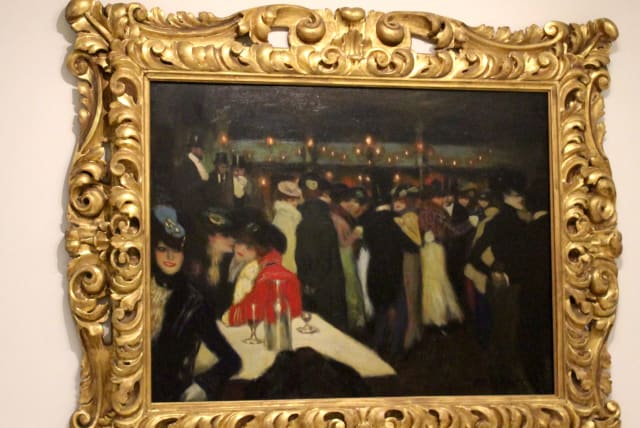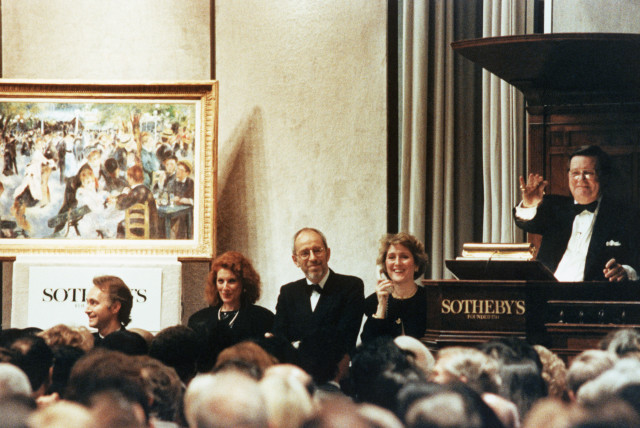Mysterious dog uncovered in scan of Picasso's painting

The dog, covered by a brown mark, was found to be a Cavalier King Charles spaniel wearing a red bow.
In Picasso’s painting Le Moulin de la Galette from the year 1900, a brown paint stroke can be seen partially covering a chair. The marking, previously thought to have been a coat, has just been uncovered to be something else entirely.
Picasso was only 19 years old when he painted the piece now valued at $78.1 million dollars, according to the Los Angeles Times.
Under close inspection, the outline of a head and ears can be seen, a dog that the artist had decided to cover.
“If you look closely, you can see that there’s this lingering ghost of the dog,” Julie Barten, senior paintings conservator at the Guggenheim Museum told global news outlet Reuters.
“There’s red paint showing through. In areas, if you look really closely, you can see the eyes here and the ears here. And you can see that, in concealing it, he actually left the contour of the top of the head still visible.”
How was the dog revealed?
Imaging was done ahead of the Young Picasso in Paris exhibition in Guggenheim.
These scans have allowed greater insight into what the dog might have looked like before it was covered up.
“Scanning X-ray fluorescence maps the distribution of elements contained in the painting, including inorganic pigments,” Barten said in an interview with Hyperallergic.
“The image of the dog is a false-color visualization that was generated by mapping the distribution of the pigments vermillion red, zinc white and iron-containing ochres.”
Who was the mystery dog?
The scans revealed the pooch to be a Cavalier King Charles spaniel wearing a red bow around its neck.
“It was interesting to me that he hastily painted over this dog, which would have been a rather compelling aspect of the composition,” Barten said in an interview with CNN.
Why was the dog removed from the painting?
Picasso regularly made changes and corrections to his works. In The Soup, from 1902, the artist had corrected a woman facing away from the viewer. In The Crouching Beggar, also from 1902, the artist concealed a disc shape under a landscape.
“We see, more and more, that this was part of Picasso’s working process,” Barten told CNN. “As he developed a composition, he would paint out certain elements, or transform them into new compositional details. And, very often, he would leave aspects of the underlying original compositions still evident to a viewer who was looking very closely.”
“It completely changes how one would have encountered this picture,” Barten is cited as saying by The Guardian. “You would have seen this really quite adorable dog in the foreground, looking almost directly at the visitor with this wonderful red bow. One can only speculate why Picasso would have concealed this. But certainly now my eye is drawn to all these wonderful figures in the composition.”
Some dog lovers might have preferred the painting with a furry friend, however historian Tom Williams does not agree. “It’s hard to imagine this particular painting with a dog in the foreground,” he told The New York Times. “I’m not sure a dog, and particularly a lap dog, makes sense in the dark, uneasy and erotically charged atmosphere that Picasso conjured up so brilliantly in this picture.”
Jerusalem Post Store
`; document.getElementById("linkPremium").innerHTML = cont; var divWithLink = document.getElementById("premium-link"); if (divWithLink !== null && divWithLink !== 'undefined') { divWithLink.style.border = "solid 1px #cb0f3e"; divWithLink.style.textAlign = "center"; divWithLink.style.marginBottom = "15px"; divWithLink.style.marginTop = "15px"; divWithLink.style.width = "100%"; divWithLink.style.backgroundColor = "#122952"; divWithLink.style.color = "#ffffff"; divWithLink.style.lineHeight = "1.5"; } } (function (v, i) { });

